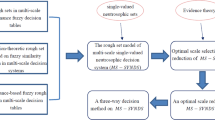Abstract
Interval neutrosophic sets (INSs) capturing the uncertainties by characterizing into the intervals of the truth, the indeterminacy, and the falsity membership degrees, is a more flexible way to explore the decision-making applications. In this paper, we develop a nonlinear programming (NP) model based on the technique for order preference by similarity to ideal solution (TOPSIS), to solve decision-making problems in which criterion values and their importance are given in the form of interval neutrosophic numbers (INNs). Based on the concept of closeness coefficient, we firstly construct a pair of the nonlinear fractional programming model and then transform it into the linear programming model. Furthermore, to determine the ranking of considered alternatives, likelihood-based comparison relations are constructed. Finally, an illustrative example demonstrates the applicability of the proposed method for dealing with decision making problems with incomplete knowledge.
Similar content being viewed by others
References
Atanassov K, Gargov G (1989) Interval-valued intuitionistic fuzzy sets. Fuzzy Sets Syst 31:343–349
Atanassov KT (1986) Intuitionistic fuzzy sets. Fuzzy Sets Syst 20:87–96
Broumi S, Smarandache F (2014) New distance and similarity measures of interval neutrosophic sets. Neutrosophic Theory and Its Applications 1:249–255
Broumi S, Smarandache F (2014) Single valued neutrosophic trapezoid linguistic aggregation operators based multi-attribute decision making. Bulletin of Pure & Applied Sciences-Mathematics and Statistics 33(2):135–155
Chi P, Liu P (2013) An extended TOPSIS method for the multiple attribute decision making problems based on interval neutrosophic set. Neutrosophic Sets and Systems 1(1):63–70
Garg H (2016) Generalized intuitionistic fuzzy interactive geometric interaction operators using Einstein t-norm and t-conorm and their application to decision making. Comput Ind Eng 101:53–69
Garg H (2016) Generalized intuitionistic fuzzy multiplicative interactive geometric operators and their application to multiple criteria decision making. Int J Mach Learn Cybern 7(6):1075–1092
Garg H (2016) A new generalized improved score function of interval-valued intuitionistic fuzzy sets and applications in expert systems. Appl Soft Comput 38:988–999
Garg H (2016) A new generalized Pythagorean fuzzy information aggregation using Einstein operations and its application to decision making. Int J Intell Syst 31(9):886–920
Garg H (2016) Some series of intuitionistic fuzzy interactive averaging aggregation operators. SpringerPlus 5(1):999. https://doi.org/10.1186/s40064-016-2591-9
Garg H (2017) Generalized Pythagorean fuzzy geometric aggregation operators using Einstein t-norm and t-conorm for multicriteria decision-making process. Int J Intell Syst 32(6):597–630
Garg H, Nancy (2016) On single-valued neutrosophic entropy of order α. Neutrosophic Sets and Systems 14:21–28
Guh YY, Hon CC, Lee ES (2001) Fuzzy weighted average: the linear programming approach via charnes and cooper’s rule. Fuzzy Sets Syst 117(1):157–160
Ji P, Zhang HY (2016) A subsethood measure with the hausdorff distance for interval neutrosophic sets and its relations with similarity and entropy measures. In: 2016 Chinese control and decision conference (CCDC). IEEE, pp 4152–4157
Li DF (2010) TOPSIS - based nonlinear-programming methodology for multiattribute decision making with interval-valued intuitionistic fuzzy sets. IEEE Trans Fuzzy Syst 18:299–311
Li DF (2011) Closeness coefficient based nonlinear programming method for interval-valued intuitionistic fuzzy multiattribute decision making with incomplete preference information. Appl Soft Comput 11(4):3402–3418
Liu P, Chu Y, Li Y, Chen Y (2014) Some generalized neutrosophic number hamacher aggregation operators and their application to group decision making. International Journal of Fuzzy Systems 16(2):242–255
Liu P, Wang Y (2014) Multiple attribute decision-making method based on single-valued neutrosophic normalized weighted bonferroni mean. Neural Comput & Applic 25(7–8):2001–2010
Majumdar P, Samant SK (2014) On similarity and entropy of neutrosophic sets. J Intell Fuzzy Syst 26 (3):1245–1252
Nancy, Garg H (2016) An improved score function for ranking neutrosophic sets and its application to decision-making process. Int J Uncertain Quantif 6(5):377–385
Nancy, Garg H (2016) Novel single-valued neutrosophic decision making operators under frank norm operations and its application. Int J Uncertain Quantif 6(4):361–375
Park JH, Park IY, Kwun YC, Tan X (2011) Extension of the TOPSIS method for decision making problems under interval-valued intuitionistic fuzzy sets. Appl Math Model 35(5):2544–2556
Peng JJ, Wang JQ, Wang J, Zhang HY, Chen ZH (2016) Simplified neutrosophic sets and their applications in multi-criteria group decision-making problems. Int J Syst Sci 47(10):2342–2358
Sahin R (2017) Cross-entropy measure on interval neutrosophic sets and its applications in multicriteria decision making. Neural Comput & Applic 28(5):1177–1187
Shui XZ, Li DQ (2003) A possibility based method for priorities of interval judgment matrix. Chinese Journal of Management Science 11(1):63–65
Smarandache F (1999) A unifying field in logics. Neutrosophy: neutrosophic probability, set and logic. American Research Press, Rehoboth
Wang H, Smarandache F, Zhang YQ, Smarandache R (2005) Interval neutrosophic sets and logic: theory and applications in computing. Hexis, Phoenix
Wang H, Smarandache F, Zhang YQ, Sunderraman R (2010) Single valued neutrosophic sets. Multispace Multistructure 4:410–413
Xu ZS (2007) Intuitionistic fuzzy aggregation operators. IEEE Trans Fuzzy Syst 15:1179–1187
Xu ZS, Yager RR (2006) Some geometric aggregation operators based on intuitionistic fuzzy sets. Int J Gen Syst 35:417–433
Ye J (2014) Similarity measures between interval neutrosophic sets and their applications in multicriteria decision-making. International Journal of Intelligent Fuzzy Systems 26(1):165–172
Ye J (2015) Improved cosine similarity measures of simplified neutrosophic sets for medical diagnoses. Artif Intell Med 63:171–179
Zadeh LA (1965) Fuzzy sets. Inf Control 8:338–353
Zhang HY, Wang JQ, Chen XH (2014) Interval neutrosophic sets and their application in multicriteria decision making problems. Sci World J 2014:645,953
Zhao H, Xu Z, Ni M, Liu S (2010) Generalized aggregation operators for intuitionistic fuzzy sets. Int J Intell Syst 25(1):1–30
Acknowledgments
The author would like to thank the Editor-in-Chief and referees for providing very helpful comments and suggestions.
Author information
Authors and Affiliations
Corresponding author
Rights and permissions
About this article
Cite this article
Garg, H., Nancy Non-linear programming method for multi-criteria decision making problems under interval neutrosophic set environment. Appl Intell 48, 2199–2213 (2018). https://doi.org/10.1007/s10489-017-1070-5
Published:
Issue Date:
DOI: https://doi.org/10.1007/s10489-017-1070-5




